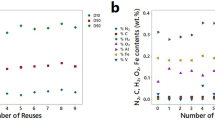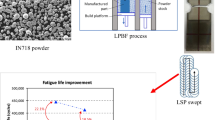Abstract
This paper aims to study the genesis of defects in titanium components made through two different additive manufacturing technologies: selective laser melting and electron beam melting. In particular, we focussed on the influence of the powders used on the formation of porosities and cavities in the manufactured components. A detailed experimental campaign was carried out to characterize the components made through the two additive manufacturing techniques aforementioned and the powders used in the process. It was found that some defects of the final components can be attributed to internal porosities of the powders used in the manufacturing process. These internal porosities are a consequence of the gas atomization process used for the production of the powders themselves. Therefore, the importance of using tailored powders, free from porosities, in order to manufacture components with high mechanical properties is highlighted.














Similar content being viewed by others
References
I. Gibson, D. Rosem, and B. Stucker, Additive Manufacturing Technologies, Springer, Berlin, 2014, p 19–42
K.V. Wong and A. Hernandez, A Review of Additive Manufacturing, Int. Sch. Res. Netw., 2012, 2012, 208760. doi:10.5402/2012/208760
W.E. Frazier, Metal Additive Manufacturing: A Review, ASM International, Materials Park, 2014
ASTM (2010), Standard Terminology for Additive Manufacturing Technologies, ASTM International, West Conshohocken, 2012
G.N. Levy, R. Schindel, and J.P. Kruth, Rapid Manufacturing and Rapid Tooling with Layer Manufacturing (LM) Technologies: State of the Art and Future Perspectives, CIRP Ann. Manuf. Technol., 2003, 52, p 589–609
D.D. Gu, W. Meiners, K. Wissenbach, and R. Poprawe, Laser Additive Manufacturing of Metallic Components: Materials, Processes and Mechanisms, Int. Mater. Rev., 2012, 57(3), p 133–164
M. Seifi, A. Salem, J. Beuth et al., Overview of Materials Qualification Needs for Metal Additive Manufacturing, JOM, 2016, 68, p 747. doi:10.1007/s11837-015-1810-0
L. Chauke, K. Mutombo, and C. Kgomo, Characterization of the Direct Metal Laser Sintered Ti6Al4V Components; 1,2,3 Material Science and Manufacturing/Light Metals, Council for Scientific and Industrial Research (CSIR), Pretoria, 2013
Y.J. Liu, S.J. Li, H.L. Wang, W.T. Hou, Y.L. Hao, R. Yang, T.B. Sercombe, and L.C. Zhang, Microstructure, Defects and Mechanical Behavior of Beta-Type Titanium Porous Structures Manufactured by Electron Beam Melting and Selective Laser Melting, Acta Mater., 2016, 113, p 56–67
Y.J. Liu, H.L. Wang, S.J. Lib, S.G. Wang, W.J. Wang, W.T. Hou, Y.L. Hao, R. Yang, and L.C. Zhang, Compressive and Fatigue Behavior of Beta-Type Titanium Porous Structures Fabricated by Electron Beam Melting, Acta Mater., 2017, 126, p 58–66
E. Sallica-Leva, A.L. Jardini, and J.B. Fogagnolo, Microstructure and Mechanical Behavior of Porous Ti-6Al-4V Parts Obtained by Selective Laser Melting, J. Mech. Behav. Biomed. Mater., 2013, 26, p 98–108
N. Dai, L.-C. Zhang, J. Zhang, X. Zhang, Q. Ni, Y. Chen, W. Maoliang, and C. Yang, Distinction in Corrosion Resistance of Selective Laser Melted Ti-6Al-4V Alloy on Different Planes, Corros. Sci., 2016, 111, p 703–710
N. Dai, L.-C. Zhang, J. Zhang, Q. Chen, and M. Wu, Corrosion Behavior of Selective Laser Melted Ti-6Al-4V Alloy in NaCl Solution, Corros. Sci., 2016, 102, p 484–489
L.E. Murr, S.A. Quinones, S.M. Gaytan, M.I. Lopez, A. Rodela, E.Y. Martinez, D.H. Hernandez, E. Martinez, F. Medina, and R.B. Wicker, Microstructure and Mechanical Behavior of Ti-6Al-4V Produced by Rapid-Layer Manufacturing, for Biomedical Applications, J. Mech. Behav. Biomed. Mater., 2009, 2, p 20–32
M. Koike, P. Greer, K. Owen, G. Lilly, L.E. Murr, S.M. Gaytan, E. Martinez, and T. Okabe, Evaluation of Titanium Alloys Fabricated Using Rapid Prototyping Technologies—Electron Beam Melting and Laser Beam Melting, Materials, 2011, 4(10), p 1776–1792. doi:10.3390/ma4101776
J.-P. Kruth, G. Levy, F. Klocke, and T.H.C. Childs, Consolidation Phenomena in Laser and Powder-Bed Based Layered Manufacturing, Ann. CIRP, 2007, 56(2), p 730. doi:10.1016/j.cirp.2007.10.004
N. Hrabe and T. Quinn, Effects of Processing on Microstructure and Mechanical Properties of a Titanium Alloy (Ti-6Al-4V) Fabricated Using Electron Beam Melting (EBM), Part 1: Distance from Build Plate and Part Size, Mater. Sci. Eng., A, 2013, 573, p 264–270
L. Loeber, S. Biamino, U. Ackelid, S. Sabbadini, P. Epicoco, P. Fino, J. Eckert, Comparison of Selective Laser and Electron Beam Melted Titanium Aluminides, in Proceedings of the Solid Freeform Fabrication Symposium, Austin, TX, USA, p 8–10.
X. Zhao et al., Comparison of the Microstructures and Mechanical Properties of Ti-6Al-4V Fabricated by Selective Laser Melting and Electron Beam Melting, Mater. Des., 2016, 95, p 21–31
S. Reginster et al., Processing of Ti Alloys by Additive Manufacturing: A Comparison of the Microstructures Obtained by Laser Cladding, Selective Laser Melting and Electron Beam Melting. Materials Science Forum, Trans Tech Publications, Clausthal-Zellerfeld, 2013
L.-C. Zhang and H. Attar, Selective Laser Melting of Titanium Alloys and Titanium Matrix Composites for Biomedical Applications: A Review, Adv. Eng. Mater., 2016, 18, p 463–475
J.H. Moll, Utilization of Gas-Atomized Titanium and Titanium-Aluminide Powder, Overv. Powder Mater., 2000, 52(5), p 32–33
H. Gong, K. Rafi, G. Hengfeng, G.D.J. Ram, T. Starr, and B. Stucker, Influence of Defects on Mechanical Properties of Ti-6Al-4V Components Produced by Selective Laser Melting and Electron Beam Melting, Mater. Des., 2015, 86(5), p 545–554
F.H. Froes, Ed., Titanium—Physical Metallurgy Processing and Applications, ASM International, Materials Park, 2015, p 172–175
L.C. Zhang, D. Klemm, J. Eckert, Y.L. Hao, and T.B. Sercombe, Manufacture by Selective Laser Melting and Mechanical Behavior of a Biomedical Ti-24Nb-4Zr-8Sn Alloy, Scr. Mater., 2011, 65, p 21–24
H. Attar, M. Calin, L.C. Zhang, S. Scudino, and J. Eckert, Manufacture by Selective Laser Melting and Mechanical Behavior of Commercially Pure Titanium, Mater. Sci. Eng., A, 2014, 593, p 170–177
N. Hrabe, T. Gnäupel-Herold, and T. Quinn, Fatigue Properties of a Titanium Alloy (Ti-6Al-4V) Fabricated Via Electron Beam Melting (EBM): Effects of Internal Defects and Residual Stress, Int. J. Fatigue, 2016, doi:10.1016/j.ijfatigue.2016.04.022
Y. Zhai, H. Galarraga, and D.A. Lados, Microstructure Evolution, Tensile Properties, and Fatigue Damage Mechanisms in Ti-6Al-4V Alloys Fabricated by Two Additive Manufacturing Techniques, Proc. Eng., 2015, 114, p 658–666
D. Gu, Y.-C. Hagedorn, W. Meiners, G. Meng, R.J.S. Batista, K. Wissenbach, and R. Poprawe, Densification Behavior, Microstructure Evolution, and Wear Performance of Selective Laser Melting Processed Commercially Pure Titanium, Acta Mater., 2012, 60, p 3849–3860
M. Xia, D. Gua, Yu Guanqun, D. Dai, H. Chen, and Q. Shi, Porosity Evolution and Its Thermodynamic Mechanism of Randomly Packed Powder-Bed During Selective Laser Melting of Inconel 718 Alloy, Int. J. Mach. Tools Manuf, 2017, 116, p 96–106
C. Qiu, N.J.E. Adkins, and M.M. Attallah, Microstructure and Tensile Properties of Selectively Laser-Melted and of HIPed Laser-Melted Ti-6Al-4V, Mater. Sci. Eng., A, 2013, 578, p 230–239
Acknowledgments
The authors are gratefully to Dr. Antonella Scherillo (STFC-ISIS Facility, RAL, OX11 0Q, Didcot, UK) for her precious support in the interpretation and discussion of the results.
Author information
Authors and Affiliations
Corresponding author
Rights and permissions
About this article
Cite this article
Iebba, M., Astarita, A., Mistretta, D. et al. Influence of Powder Characteristics on Formation of Porosity in Additive Manufacturing of Ti-6Al-4V Components. J. of Materi Eng and Perform 26, 4138–4147 (2017). https://doi.org/10.1007/s11665-017-2796-2
Received:
Revised:
Published:
Issue Date:
DOI: https://doi.org/10.1007/s11665-017-2796-2




